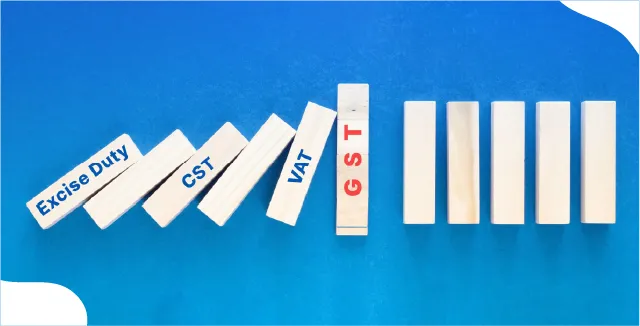
Author
LoansJagat Team
Read Time
6 Min
23 Jul 2025
Cascading Effect – Meaning, Definition & Real-Life Examples
The cascading effect happens when a tax is charged on top of another tax already included in the price. This leads to higher costs for buyers and makes goods and services more expensive.
Let’s understand this through an example of Ravi, who manufactures wooden furniture. He buys raw materials and sells finished products. Due to the cascading effect (before GST), he had to pay tax on the tax already paid by his supplier.
Here, Ravi paid ₹100 tax while buying wood. When he sold the finished furniture for ₹1,600, he again paid ₹160 tax without getting credit for the ₹100 he had already paid. So, tax is charged on ₹1,600 instead of ₹500 – this is the cascading effect.
Real-Life Example of the Cascading Effect in the Textile Industry
Let’s take a closer look at how the cascading effect worked before GST through the journey of cotton becoming fabric.
A textile manufacturer buys raw cotton for ₹100 per kg and pays 10% tax, making the cost ₹110 per kg.
He then processes it into fabric and sells it to a wholesaler for ₹200 per kg. Again, a 10% tax is added, pushing the price up to ₹220 per kg.
Next, the wholesaler sells it to a retailer for ₹300 per kg and adds another 10% tax, bringing the final price to ₹330 per kg.
Here’s a breakdown:
At each step, the tax was charged on the already taxed price, which kept increasing the final cost. This is a clear example of the cascading effect, where tax-on-tax raises the burden on the end consumer.
Read More - What is Monopoly?
To solve this issue, the Government of India introduced GST, which allows tax credit at every stage. This way, businesses only pay tax on the value they add, not on the total taxed amount, making prices fairer and reducing the overall tax burden.
How India Eliminated the Cascading Effect Through GST?
To remove the burden of tax-on-tax, India introduced the Goods and Services Tax (GST) in 2017. Before GST, India’s tax system was filled with multiple indirect taxes such as excise duty, VAT, and service tax. These were applied at different stages without giving credit for previously paid taxes, which led to a cascading effect.
With the arrival of GST, India adopted a unified tax structure similar to many developed countries. GST follows the Value Added Tax (VAT) principle, where tax is applied only on the value added at each step of the supply chain.
In the GST system, businesses can claim credit for the GST they have already paid on purchases (inputs). This is called Input Tax Credit (ITC). It ensures that tax is not applied repeatedly on the same value, helping reduce the overall tax burden.
Here’s how it works:
Input Tax Credit under GST = GST on sale (output) − GST paid on purchases (input)
By using this system, India has successfully removed the cascading effect and made taxation more transparent, fair, and efficient for both businesses and consumers.
Why Understanding the Cascading Effect Matters in Taxation?
Understanding the cascading effect is important because it shows how unfair and costly taxation used to be before reforms like the GST. When taxes are applied on top of already taxed goods or services, the final cost increases for no valid reason. This affects not only businesses but also everyday consumers, who end up paying much more than they should.
Let’s understand this with an example of a man named Amit, who runs a sweet shop.
Amit buys raw sugar to make sweets. He pays tax on the sugar. Later, he sells the sweets and again pays tax on the total price, which already includes the taxed sugar. The same happens when a wholesaler and then a retailer buy and sell the sweets.
Here, every tax is calculated on the total amount, including previously taxed values. This is unfair to both sellers and buyers. Amit pays tax on sugar, again on sweets, and the retailer does the same. This is classic tax on tax, or the cascading effect.
Why It Matters
- It raises prices at every level of trade.
- It reduces transparency, as no one knows the real tax amount.
- It harms small businesses, which cannot afford the repeated taxes.
- It affects consumers, who unknowingly pay inflated prices.
By understanding the cascading effect, we see why India moved to GST, a system that charges tax only on the value added, not on the entire amount again. This makes taxation fair, simple, and transparent for everyone.
Impact of Cascading Taxes on Consumers
Cascading taxes directly affect consumers by making goods and services more expensive than they should be. When each stage of production or sale adds a new layer of tax without adjusting for the tax already paid, the final price keeps rising.
For example, if a manufacturer pays tax on raw materials and then again on the finished product (which includes the cost of the taxed materials), the total price increases unfairly. The next seller repeats the same process, and by the time the product reaches the customer, it includes multiple layers of tax.
As a result, consumers end up:
- Paying more than the actual value of the product.
- They receive no clarity on how much tax they truly pay.
- Facing higher prices even on basic items.
How Does The Cascading Effect Increase The Cost of Living?
The cascading effect makes life more expensive by adding tax on top of tax at every stage of production and sale. Each business in the supply chain pays tax on the total price, including earlier taxes. In the end, consumers pay the highest price, even though the actual value of the product has not increased that much.
Also Read - What is a Mixed Economy?
Let’s look at a simple example of a daily-use item like a cooking pan:
Here, each stage adds tax on the previously taxed amount. The retailer’s ₹100 tax includes tax on the earlier ₹80, which already included a ₹50 tax on metal.
So, the final price to the consumer becomes ₹1,100 even though the original material cost was only ₹500.
This hidden layering of taxes:
- Inflates the prices of essential items
- Reduces affordability for average families
- Increases the cost of living over time
By removing the cascading effect (through GST), consumers pay tax only on the added value, not on previously taxed costs, leading to fairer prices and lower living expenses.
Conclusion
The cascading effect is an important concept in taxation that helps us understand how tax on tax increases the cost of goods and services. It happens when each stage of production and sale adds a new tax without considering the tax already paid earlier. This results in higher prices for the end consumer, even if the actual value of the product does not increase much.
The cascading effect leads to unfair pricing, a lack of transparency, and a heavier burden on both businesses and consumers. For example, tax gets added at each stage—on raw materials, finished goods, and final sales, causing a rise in the overall price.
This highlights why India introduced GST, which allows businesses to claim input tax credit. As a result, tax is applied only on the added value, not on the entire taxed amount, making the system fairer and more efficient.
FAQ’s
1. What is the cascading effect in taxation?
It is when tax is charged on a product that already includes a previous tax, causing tax-on-tax.
2. Why does the cascading effect increase prices?
Because each seller adds tax without adjusting for earlier taxes, leading to higher final costs.
3. Who suffers the most from the cascading effect?
Consumers pay the highest price as every stage adds tax, increasing the total cost.
4. How does GST remove the cascading effect?
GST allows businesses to claim tax credit, so tax applies only on the added value, not the total cost.
5. Can the cascading effect affect daily-use items?
Yes, even common goods like food and clothing become more expensive due to repeated taxation.
About the Author

LoansJagat Team
‘Simplify Finance for Everyone.’ This is the common goal of our team, as we try to explain any topic with relatable examples. From personal to business finance, managing EMIs to becoming debt-free, we do extensive research on each and every parameter, so you don’t have to. Scroll up and have a look at what 15+ years of experience in the BFSI sector looks like.

Quick Apply Loan
Subscribe Now
Related Blog Post


